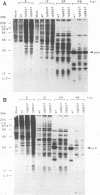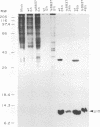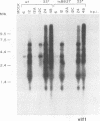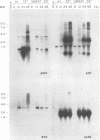Abstract
We have identified a gene required for strong expression of the polyhedrin gene by characterizing a mutant, tsB837, of the baculovirus Autographa californica nuclear polyhedrosis virus (AcMNPV) which is temperature sensitive (ts) for occluded virus production at the nonpermissive temperature. Marker rescue experiments utilizing an overlapping set of AcMNPV genomic clones revealed that the gene responsible for the ts mutant phenotype mapped to a region between 46 and 48 map units. Fragments (2.2 kb) from both wild-type AcMNPV and tsB837 genomes spanning the mutated region were sequenced, and a single nucleotide difference was observed. This mutation is predicted to substitute a single amino acid within a 44.4-kDa polypeptide. Analysis of protein synthesis in wild-type- and mutant-infected cells at the nonpermissive temperature indicated that polyhedrin synthesis was dramatically reduced in the mutant. Northern (RNA) blot analysis revealed that the mutant had markedly reduced levels of polyhedrin transcripts. Transcripts of another very late gene, p10, were also reduced but to a lesser degree. The transcription of two late genes (603 ORF and vp39) was neither reduced nor temporally delayed. Thus, the gene encoding this very late expression factor, designated vlf-1, regulates the levels of very late gene transcripts, and the tsB837 mutation affects the levels of polyhedrin gene transcripts more strongly than those of p10 transcripts. The product of the newly identified gene has a surprising but significant relationship to a family of integrases and resolvases.
Full text
PDF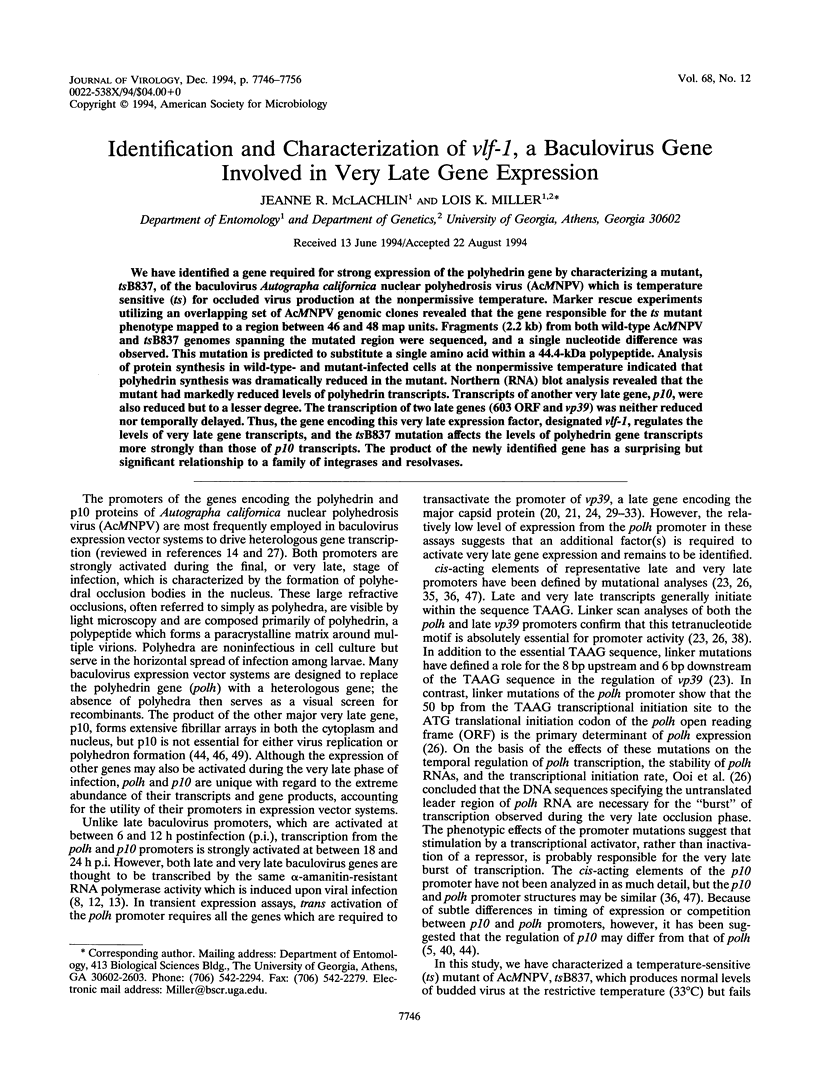
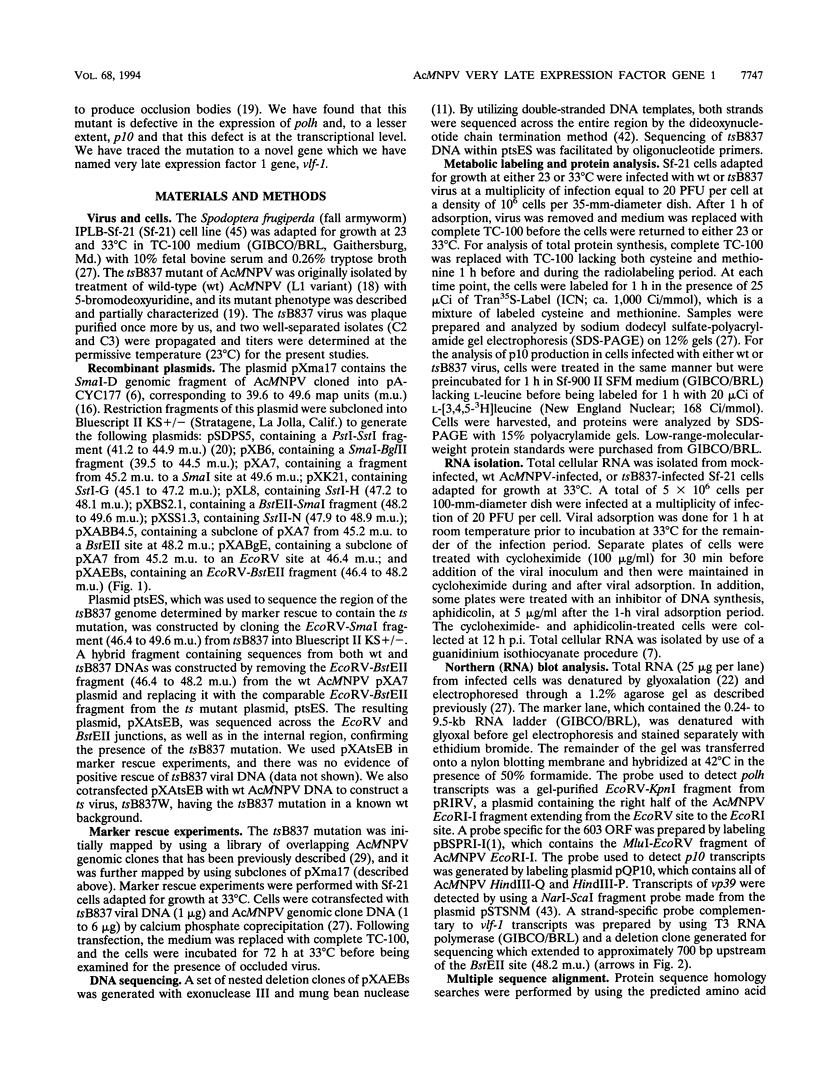
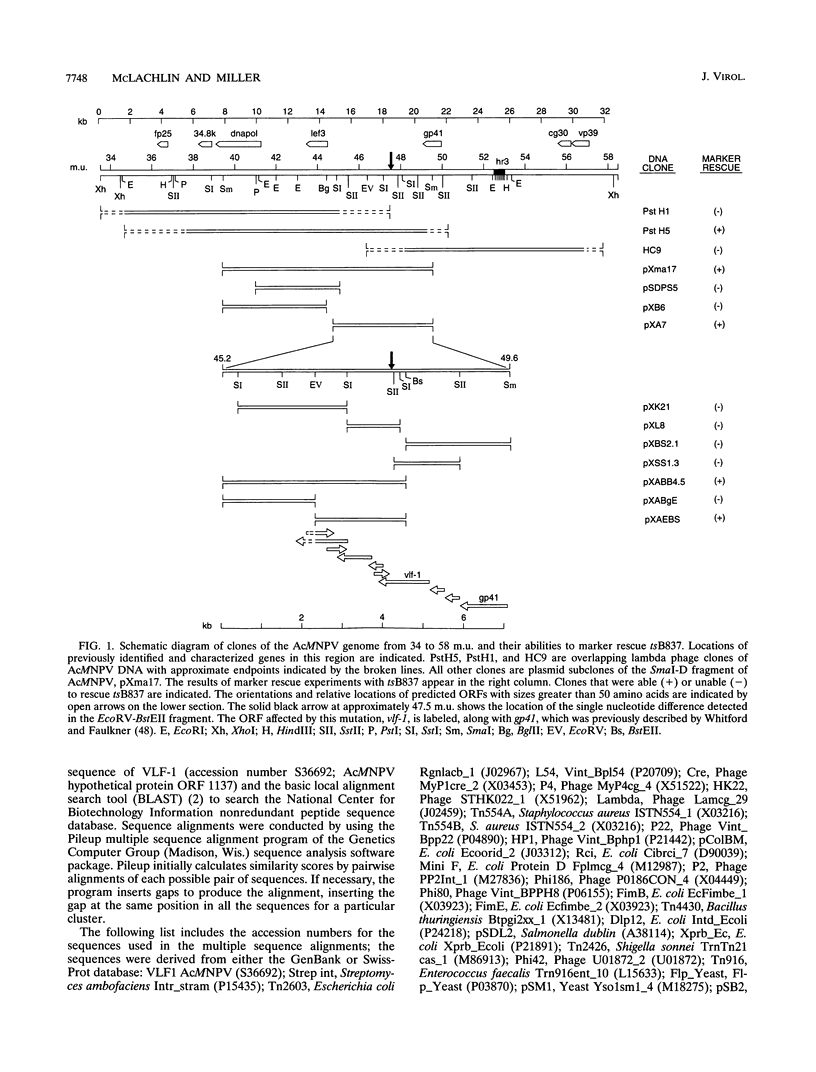
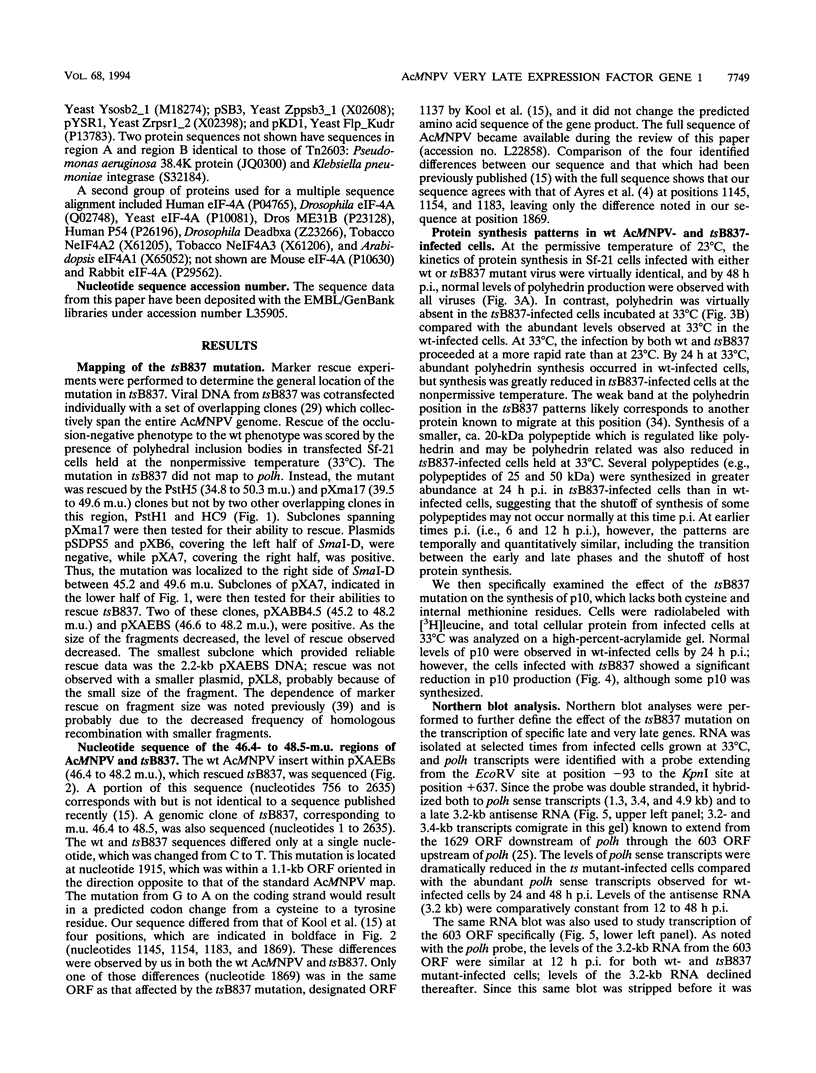
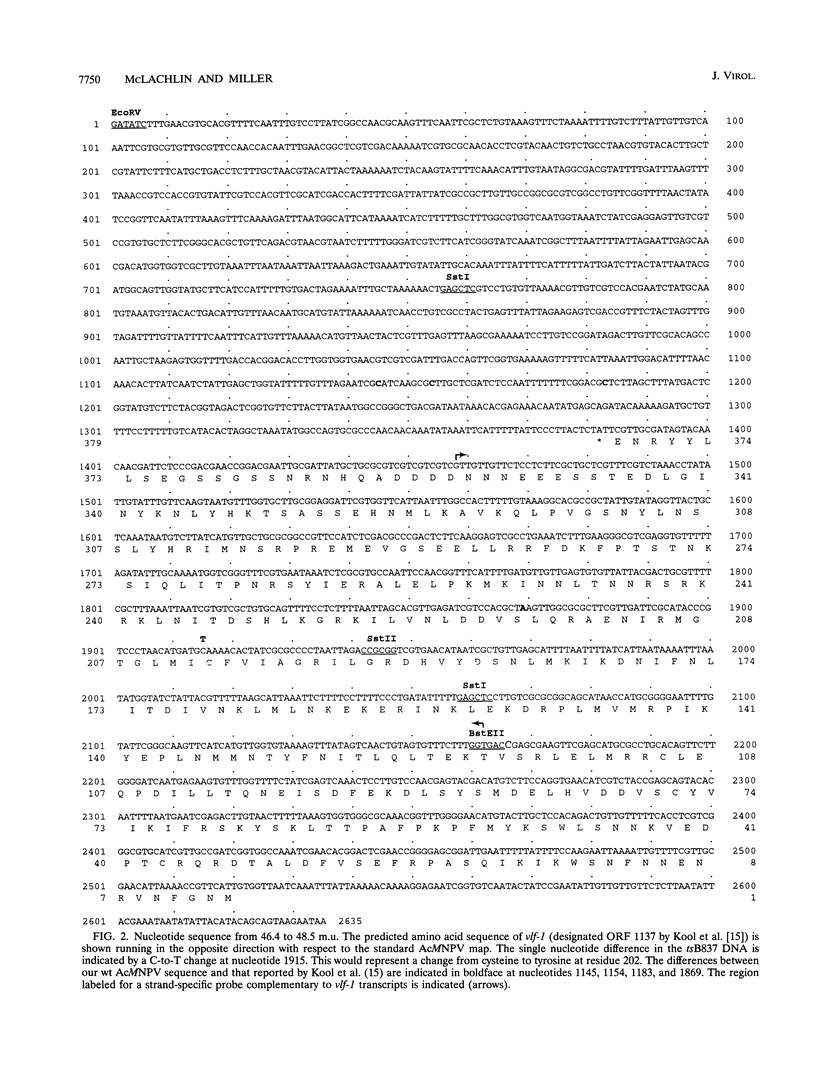
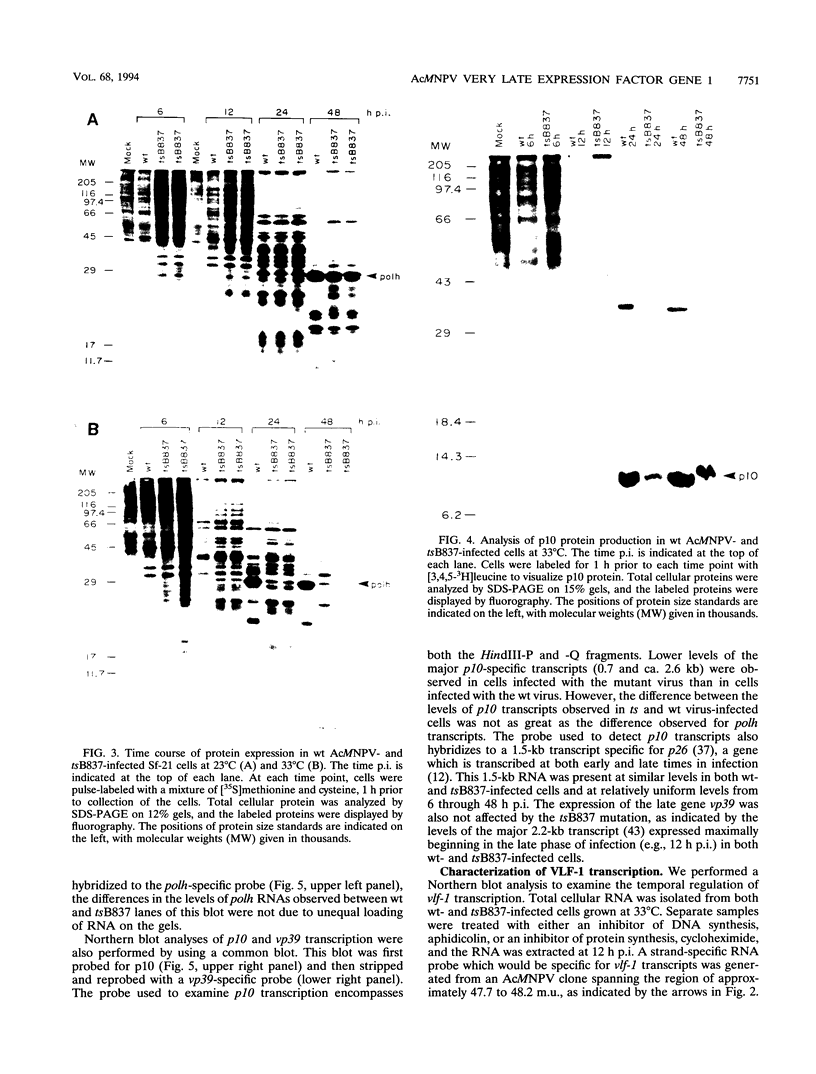
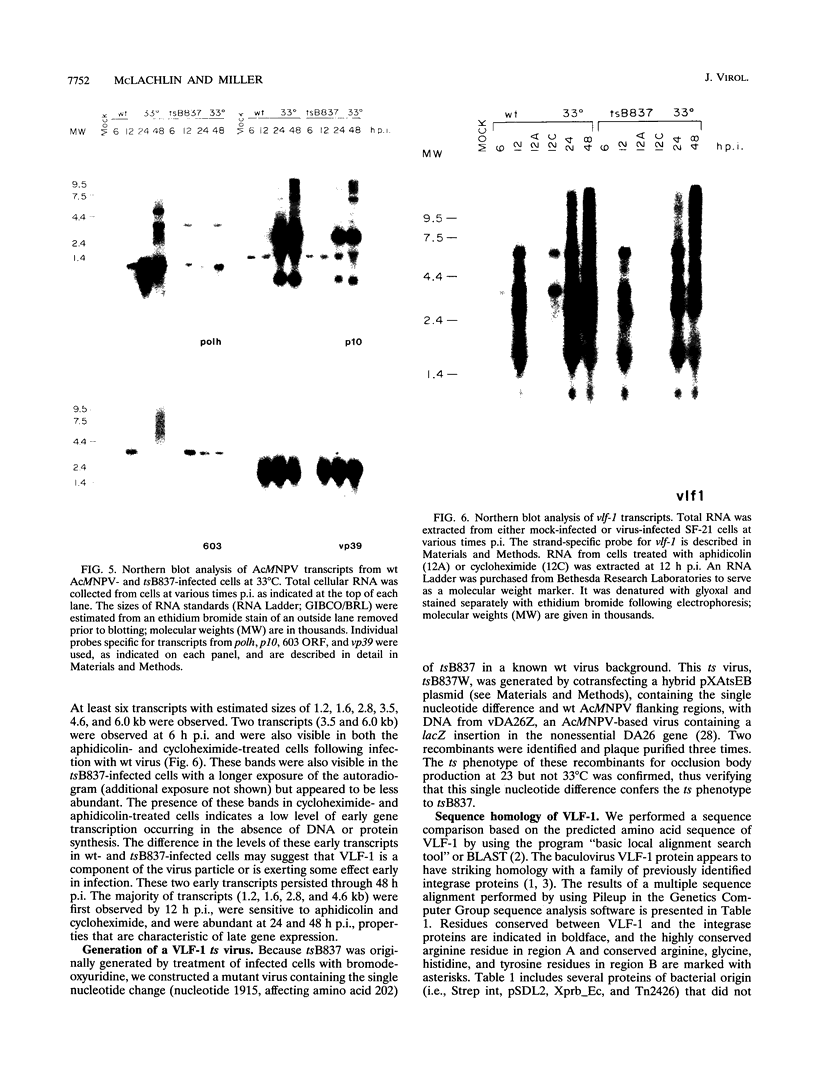

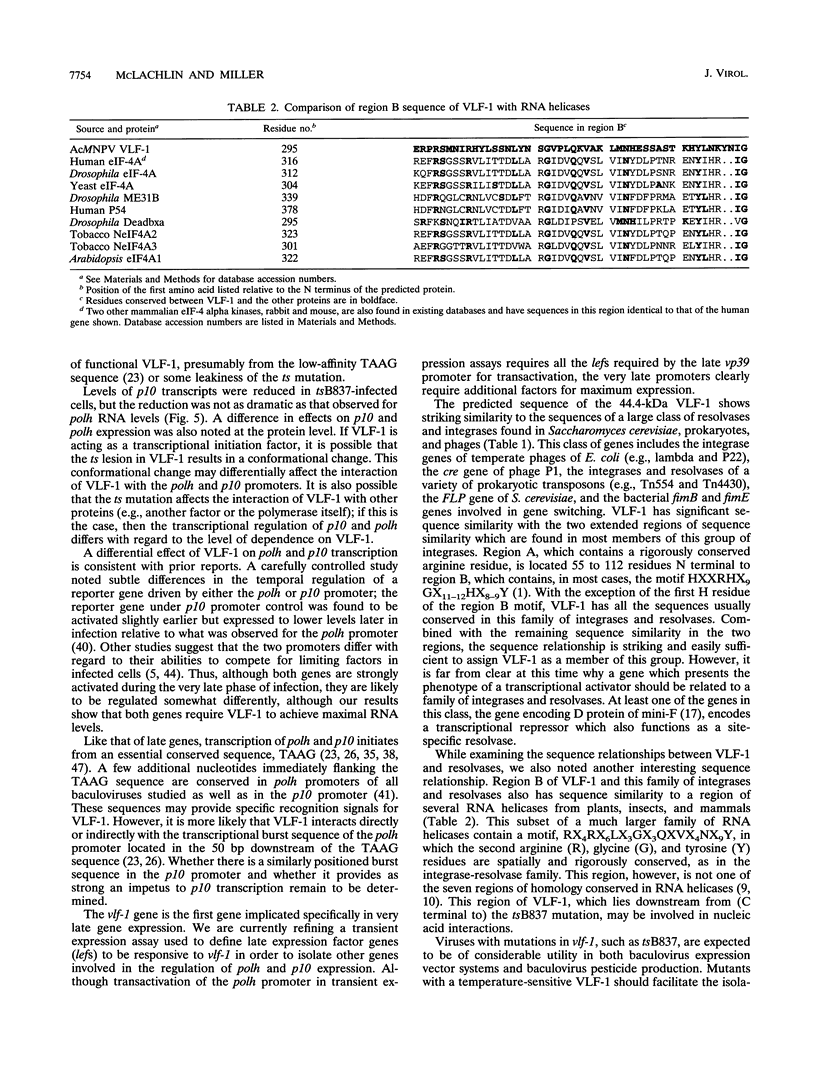
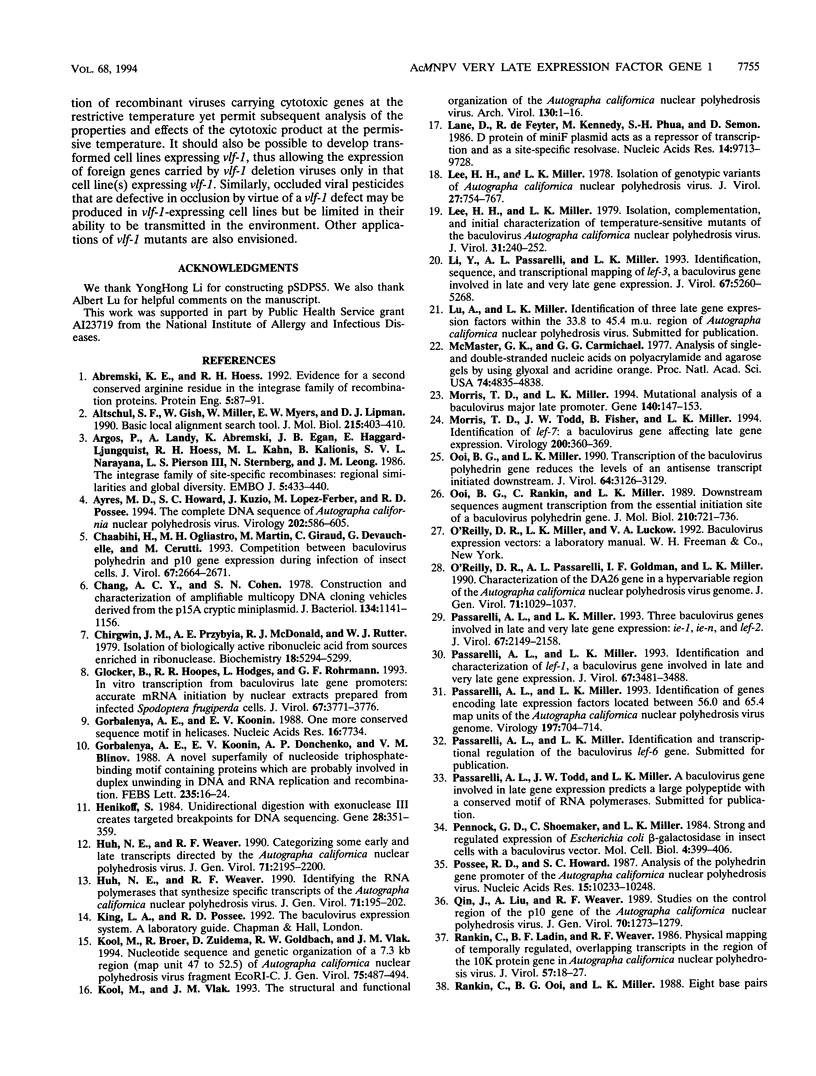
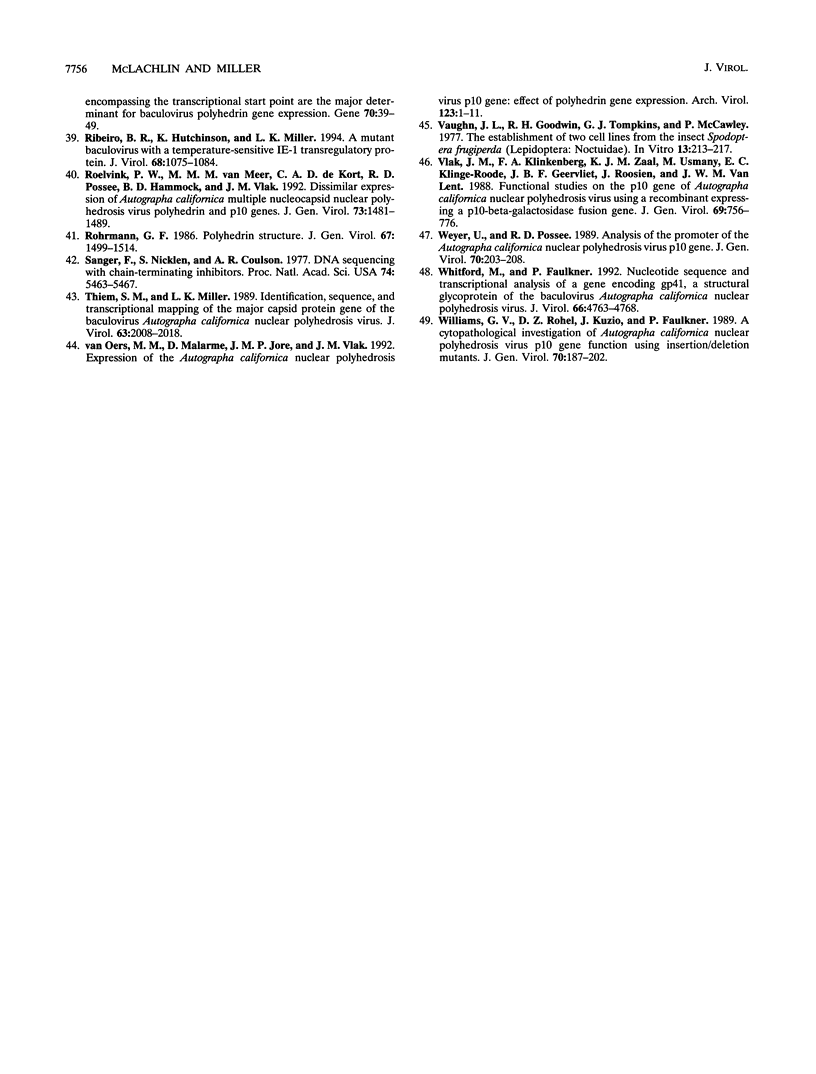
Images in this article
Selected References
These references are in PubMed. This may not be the complete list of references from this article.
- Abremski K. E., Hoess R. H. Evidence for a second conserved arginine residue in the integrase family of recombination proteins. Protein Eng. 1992 Jan;5(1):87–91. doi: 10.1093/protein/5.1.87. [DOI] [PubMed] [Google Scholar]
- Altschul S. F., Gish W., Miller W., Myers E. W., Lipman D. J. Basic local alignment search tool. J Mol Biol. 1990 Oct 5;215(3):403–410. doi: 10.1016/S0022-2836(05)80360-2. [DOI] [PubMed] [Google Scholar]
- Argos P., Landy A., Abremski K., Egan J. B., Haggard-Ljungquist E., Hoess R. H., Kahn M. L., Kalionis B., Narayana S. V., Pierson L. S., 3rd The integrase family of site-specific recombinases: regional similarities and global diversity. EMBO J. 1986 Feb;5(2):433–440. doi: 10.1002/j.1460-2075.1986.tb04229.x. [DOI] [PMC free article] [PubMed] [Google Scholar]
- Ayres M. D., Howard S. C., Kuzio J., Lopez-Ferber M., Possee R. D. The complete DNA sequence of Autographa californica nuclear polyhedrosis virus. Virology. 1994 Aug 1;202(2):586–605. doi: 10.1006/viro.1994.1380. [DOI] [PubMed] [Google Scholar]
- Chaabihi H., Ogliastro M. H., Martin M., Giraud C., Devauchelle G., Cerutti M. Competition between baculovirus polyhedrin and p10 gene expression during infection of insect cells. J Virol. 1993 May;67(5):2664–2671. doi: 10.1128/jvi.67.5.2664-2671.1993. [DOI] [PMC free article] [PubMed] [Google Scholar]
- Chang A. C., Cohen S. N. Construction and characterization of amplifiable multicopy DNA cloning vehicles derived from the P15A cryptic miniplasmid. J Bacteriol. 1978 Jun;134(3):1141–1156. doi: 10.1128/jb.134.3.1141-1156.1978. [DOI] [PMC free article] [PubMed] [Google Scholar]
- Chirgwin J. M., Przybyla A. E., MacDonald R. J., Rutter W. J. Isolation of biologically active ribonucleic acid from sources enriched in ribonuclease. Biochemistry. 1979 Nov 27;18(24):5294–5299. doi: 10.1021/bi00591a005. [DOI] [PubMed] [Google Scholar]
- Glocker B., Hoopes R. R., Jr, Hodges L., Rohrmann G. F. In vitro transcription from baculovirus late gene promoters: accurate mRNA initiation by nuclear extracts prepared from infected Spodoptera frugiperda cells. J Virol. 1993 Jul;67(7):3771–3776. doi: 10.1128/jvi.67.7.3771-3776.1993. [DOI] [PMC free article] [PubMed] [Google Scholar]
- Gorbalenya A. E., Koonin E. V., Donchenko A. P., Blinov V. M. A novel superfamily of nucleoside triphosphate-binding motif containing proteins which are probably involved in duplex unwinding in DNA and RNA replication and recombination. FEBS Lett. 1988 Aug 1;235(1-2):16–24. doi: 10.1016/0014-5793(88)81226-2. [DOI] [PMC free article] [PubMed] [Google Scholar]
- Gorbalenya A. E., Koonin E. V. One more conserved sequence motif in helicases. Nucleic Acids Res. 1988 Aug 11;16(15):7734–7734. doi: 10.1093/nar/16.15.7734. [DOI] [PMC free article] [PubMed] [Google Scholar]
- Henikoff S. Unidirectional digestion with exonuclease III creates targeted breakpoints for DNA sequencing. Gene. 1984 Jun;28(3):351–359. doi: 10.1016/0378-1119(84)90153-7. [DOI] [PubMed] [Google Scholar]
- Huh N. E., Weaver R. F. Categorizing some early and late transcripts directed by the Autographa californica nuclear polyhedrosis virus. J Gen Virol. 1990 Sep;71(Pt 9):2195–2200. doi: 10.1099/0022-1317-71-9-2195. [DOI] [PubMed] [Google Scholar]
- Huh N. E., Weaver R. F. Identifying the RNA polymerases that synthesize specific transcripts of the Autographa californica nuclear polyhedrosis virus. J Gen Virol. 1990 Jan;71(Pt 1):195–201. doi: 10.1099/0022-1317-71-1-195. [DOI] [PubMed] [Google Scholar]
- Kool M., Broer R., Zuidema D., Goldbach R. W., Vlak J. M. Nucleotide sequence and genetic organization of a 7.3 kb region (map unit 47 to 52.5) of Autographa californica nuclear polyhedrosis virus fragment EcoRI-C. J Gen Virol. 1994 Mar;75(Pt 3):487–494. doi: 10.1099/0022-1317-75-3-487. [DOI] [PubMed] [Google Scholar]
- Kool M., Vlak J. M. The structural and functional organization of the Autographa californica nuclear polyhedrosis virus genome. Arch Virol. 1993;130(1-2):1–16. doi: 10.1007/BF01318992. [DOI] [PubMed] [Google Scholar]
- Lane D., de Feyter R., Kennedy M., Phua S. H., Semon D. D protein of miniF plasmid acts as a repressor of transcription and as a site-specific resolvase. Nucleic Acids Res. 1986 Dec 22;14(24):9713–9728. [PMC free article] [PubMed] [Google Scholar]
- Lee H. H., Miller L. K. Isolation of genotypic variants of Autographa californica nuclear polyhedrosis virus. J Virol. 1978 Sep;27(3):754–767. doi: 10.1128/jvi.27.3.754-767.1978. [DOI] [PMC free article] [PubMed] [Google Scholar]
- Lee H. H., Miller L. K. Isolation, Complementation, and Initial Characterization of Temperature-Sensitive Mutants of the Baculovirus Autographa californica Nuclear Polyhedrosis Virus. J Virol. 1979 Jul;31(1):240–252. doi: 10.1128/jvi.31.1.240-252.1979. [DOI] [PMC free article] [PubMed] [Google Scholar]
- Li Y., Passarelli A. L., Miller L. K. Identification, sequence, and transcriptional mapping of lef-3, a baculovirus gene involved in late and very late gene expression. J Virol. 1993 Sep;67(9):5260–5268. doi: 10.1128/jvi.67.9.5260-5268.1993. [DOI] [PMC free article] [PubMed] [Google Scholar]
- McMaster G. K., Carmichael G. G. Analysis of single- and double-stranded nucleic acids on polyacrylamide and agarose gels by using glyoxal and acridine orange. Proc Natl Acad Sci U S A. 1977 Nov;74(11):4835–4838. doi: 10.1073/pnas.74.11.4835. [DOI] [PMC free article] [PubMed] [Google Scholar]
- Morris T. D., Miller L. K. Mutational analysis of a baculovirus major late promoter. Gene. 1994 Mar 25;140(2):147–153. doi: 10.1016/0378-1119(94)90538-x. [DOI] [PubMed] [Google Scholar]
- Morris T. D., Todd J. W., Fisher B., Miller L. K. Identification of lef-7: a baculovirus gene affecting late gene expression. Virology. 1994 May 1;200(2):360–369. doi: 10.1006/viro.1994.1200. [DOI] [PubMed] [Google Scholar]
- O'Reilly D. R., Passarelli A. L., Goldman I. F., Miller L. K. Characterization of the DA26 gene in a hypervariable region of the Autographa californica nuclear polyhedrosis virus genome. J Gen Virol. 1990 May;71(Pt 5):1029–1037. doi: 10.1099/0022-1317-71-5-1029. [DOI] [PubMed] [Google Scholar]
- Ooi B. G., Miller L. K. Transcription of the baculovirus polyhedrin gene reduces the levels of an antisense transcript initiated downstream. J Virol. 1990 Jun;64(6):3126–3129. doi: 10.1128/jvi.64.6.3126-3129.1990. [DOI] [PMC free article] [PubMed] [Google Scholar]
- Ooi B. G., Rankin C., Miller L. K. Downstream sequences augment transcription from the essential initiation site of a baculovirus polyhedrin gene. J Mol Biol. 1989 Dec 20;210(4):721–736. doi: 10.1016/0022-2836(89)90105-8. [DOI] [PubMed] [Google Scholar]
- Passarelli A. L., Miller L. K. Identification and characterization of lef-1, a baculovirus gene involved in late and very late gene expression. J Virol. 1993 Jun;67(6):3481–3488. doi: 10.1128/jvi.67.6.3481-3488.1993. [DOI] [PMC free article] [PubMed] [Google Scholar]
- Passarelli A. L., Miller L. K. Identification of genes encoding late expression factors located between 56.0 and 65.4 map units of the Autographa californica nuclear polyhedrosis virus genome. Virology. 1993 Dec;197(2):704–714. doi: 10.1006/viro.1993.1646. [DOI] [PubMed] [Google Scholar]
- Passarelli A. L., Miller L. K. Three baculovirus genes involved in late and very late gene expression: ie-1, ie-n, and lef-2. J Virol. 1993 Apr;67(4):2149–2158. doi: 10.1128/jvi.67.4.2149-2158.1993. [DOI] [PMC free article] [PubMed] [Google Scholar]
- Pennock G. D., Shoemaker C., Miller L. K. Strong and regulated expression of Escherichia coli beta-galactosidase in insect cells with a baculovirus vector. Mol Cell Biol. 1984 Mar;4(3):399–406. doi: 10.1128/mcb.4.3.399. [DOI] [PMC free article] [PubMed] [Google Scholar]
- Possee R. D., Howard S. C. Analysis of the polyhedrin gene promoter of the Autographa californica nuclear polyhedrosis virus. Nucleic Acids Res. 1987 Dec 23;15(24):10233–10248. doi: 10.1093/nar/15.24.10233. [DOI] [PMC free article] [PubMed] [Google Scholar]
- Qin J. C., Liu A. F., Weaver R. F. Studies on the control region of the p10 gene of the Autographa californica nuclear polyhedrosis virus. J Gen Virol. 1989 May;70(Pt 5):1273–1279. doi: 10.1099/0022-1317-70-5-1273. [DOI] [PubMed] [Google Scholar]
- Rankin C., Ladin B. F., Weaver R. F. Physical mapping of temporally regulated, overlapping transcripts in the region of the 10K protein gene in Autographa californica nuclear polyhedrosis virus. J Virol. 1986 Jan;57(1):18–27. doi: 10.1128/jvi.57.1.18-27.1986. [DOI] [PMC free article] [PubMed] [Google Scholar]
- Rankin C., Ooi B. G., Miller L. K. Eight base pairs encompassing the transcriptional start point are the major determinant for baculovirus polyhedrin gene expression. Gene. 1988 Oct 15;70(1):39–49. doi: 10.1016/0378-1119(88)90102-3. [DOI] [PubMed] [Google Scholar]
- Ribeiro B. M., Hutchinson K., Miller L. K. A mutant baculovirus with a temperature-sensitive IE-1 transregulatory protein. J Virol. 1994 Feb;68(2):1075–1084. doi: 10.1128/jvi.68.2.1075-1084.1994. [DOI] [PMC free article] [PubMed] [Google Scholar]
- Roelvink P. W., van Meer M. M., de Kort C. A., Possee R. D., Hammock B. D., Vlak J. M. Dissimilar expression of Autographa californica multiple nucleocapsid nuclear polyhedrosis virus polyhedrin and p10 genes. J Gen Virol. 1992 Jun;73(Pt 6):1481–1489. doi: 10.1099/0022-1317-73-6-1481. [DOI] [PubMed] [Google Scholar]
- Rohrmann G. F. Polyhedrin structure. J Gen Virol. 1986 Aug;67(Pt 8):1499–1513. doi: 10.1099/0022-1317-67-8-1499. [DOI] [PubMed] [Google Scholar]
- Sanger F., Nicklen S., Coulson A. R. DNA sequencing with chain-terminating inhibitors. Proc Natl Acad Sci U S A. 1977 Dec;74(12):5463–5467. doi: 10.1073/pnas.74.12.5463. [DOI] [PMC free article] [PubMed] [Google Scholar]
- Thiem S. M., Miller L. K. Identification, sequence, and transcriptional mapping of the major capsid protein gene of the baculovirus Autographa californica nuclear polyhedrosis virus. J Virol. 1989 May;63(5):2008–2018. doi: 10.1128/jvi.63.5.2008-2018.1989. [DOI] [PMC free article] [PubMed] [Google Scholar]
- Vaughn J. L., Goodwin R. H., Tompkins G. J., McCawley P. The establishment of two cell lines from the insect Spodoptera frugiperda (Lepidoptera; Noctuidae). In Vitro. 1977 Apr;13(4):213–217. doi: 10.1007/BF02615077. [DOI] [PubMed] [Google Scholar]
- Vlak J. M., Klinkenberg F. A., Zaal K. J., Usmany M., Klinge-Roode E. C., Geervliet J. B., Roosien J., van Lent J. W. Functional studies on the p10 gene of Autographa californica nuclear polyhedrosis virus using a recombinant expressing a p10-beta-galactosidase fusion gene. J Gen Virol. 1988 Apr;69(Pt 4):765–776. doi: 10.1099/0022-1317-69-4-765. [DOI] [PubMed] [Google Scholar]
- Weyer U., Possee R. D. Analysis of the promoter of the Autographa californica nuclear polyhedrosis virus p10 gene. J Gen Virol. 1989 Jan;70(Pt 1):203–208. doi: 10.1099/0022-1317-70-1-203. [DOI] [PubMed] [Google Scholar]
- Whitford M., Faulkner P. Nucleotide sequence and transcriptional analysis of a gene encoding gp41, a structural glycoprotein of the baculovirus Autographa californica nuclear polyhedrosis virus. J Virol. 1992 Aug;66(8):4763–4768. doi: 10.1128/jvi.66.8.4763-4768.1992. [DOI] [PMC free article] [PubMed] [Google Scholar]
- Williams G. V., Rohel D. Z., Kuzio J., Faulkner P. A cytopathological investigation of Autographa californica nuclear polyhedrosis virus p10 gene function using insertion/deletion mutants. J Gen Virol. 1989 Jan;70(Pt 1):187–202. doi: 10.1099/0022-1317-70-1-187. [DOI] [PubMed] [Google Scholar]
- van Oers M. M., Malarme D., Jore J. M., Vlak J. M. Expression of the Autographa californica nuclear polyhedrosis virus p10 gene: effect of polyhedrin gene expression. Arch Virol. 1992;123(1-2):1–11. doi: 10.1007/BF01317134. [DOI] [PubMed] [Google Scholar]



